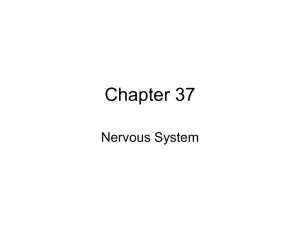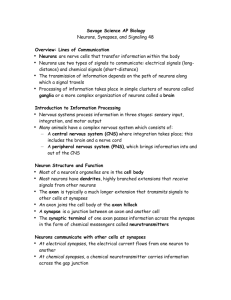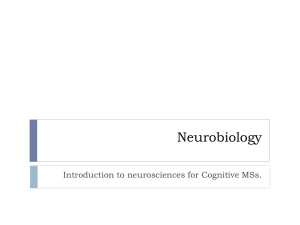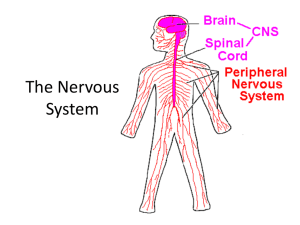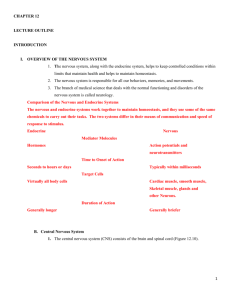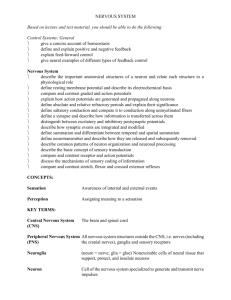Name: ANSWERS_______________________________ Period
advertisement
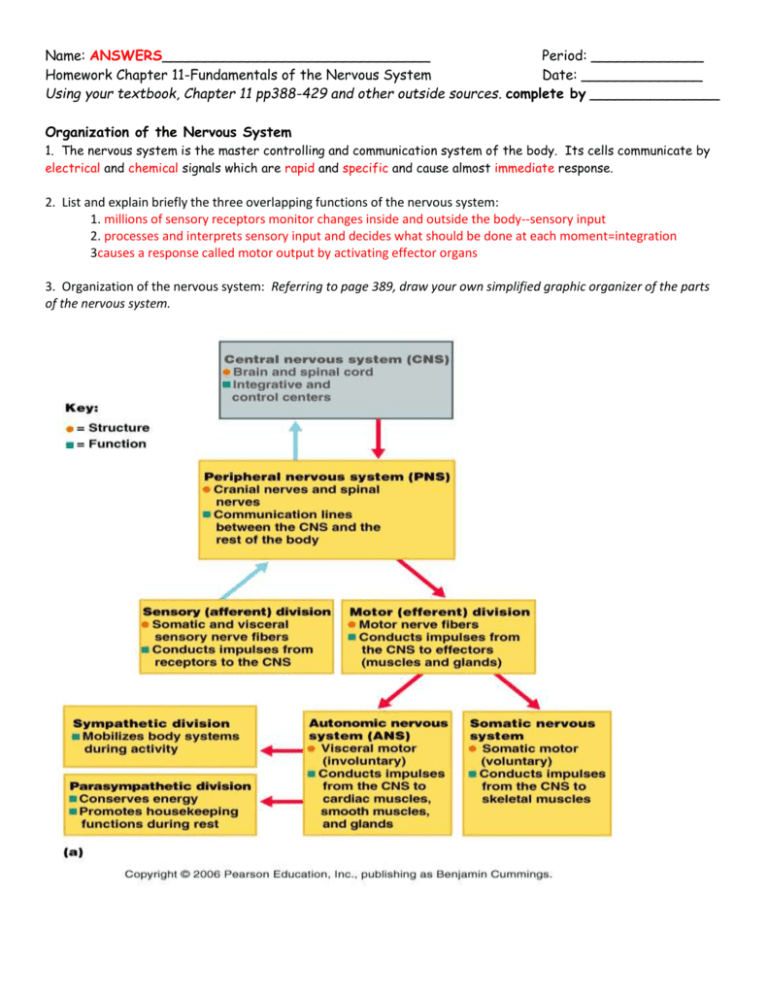
Name: ANSWERS_______________________________ Period: _____________ Homework Chapter 11-Fundamentals of the Nervous System Date: ______________ Using your textbook, Chapter 11 pp388-429 and other outside sources. complete by _______________ Organization of the Nervous System 1. The nervous system is the master controlling and communication system of the body. Its cells communicate by electrical and chemical signals which are rapid and specific and cause almost immediate response. 2. List and explain briefly the three overlapping functions of the nervous system: 1. millions of sensory receptors monitor changes inside and outside the body--sensory input 2. processes and interprets sensory input and decides what should be done at each moment=integration 3causes a response called motor output by activating effector organs 3. Organization of the nervous system: Referring to page 389, draw your own simplified graphic organizer of the parts of the nervous system. 4. Choose the words that best matches the following descriptions. A. Autonomic Nervous system B. Central Nervous system B D C A B 1. 2. 3. 4. 5. C. Peripheral Nervous system D. Somatic Nervous system Nervous system division that is composed of brain and spinal cord Subdivision of the peripheral nervous system (PNS) that controls voluntary activities like moving our hand. Nervous system subdivision that consists of cranial and spinal nerves and ganglia Subdivision of PNS that regulates heart and smooth muscle; involuntary Interprets incoming information and issues orders Histology of Nervous Tissue 5. Nervous tissue is highly cellular. Cells are densely packed and intertwined. There are two principal types of cells: neurons and supporting cells. In the following exercise, write true if the statement is true but if the statement is false, change the underlined word to make the statement true and write the correct word on the answer blank. TRUE 1. Supporting cells in the nervous system are called neuroglia or simply glia Neuroglia 2. Neurons are highly mitotic and therefore are responsible for most brain neoplasms (tumors). PNS 3. Schwann cells and satellite cells are found only the CNS TRUE 4. Ependymal cells line cavities of the brain and spinal cord and many have cilia TRUE 5. Oligodendrocytes produce myelin in the CNS but Schwann cells produce myelin in the PNS Microglia 6. Astrocytes engulf invading microorganisms and dead neural tissue. TRUE 7. Neurons have a high metabolic rate and cannot survive for more than a few minutes without oxygen Astrocytes 8. Radiating processes of neurons cling to capillaries. TRUE 9. Astrocytes are the most abundant and versatile of the glial cells 6. Match the anatomical term in Column B with the description of function in Column A. Column A Column B B 1. Releases neurotransmitters A. Axon D 2. Conducts information toward cell body B. Axon Terminal E 3. Increases the speed of impulse transmission C. Cell Body (soma) C 4. location of nucleus D. Dendrite A 5. conducts information away from cell body E. Myelin sheath C 6. Most are located and protected within the CNS F. Nissl bodies D 7. Short, diffusely branched extensions from cell body A 8. This process is sometimes referred to as a nerve fiber E 9. Formed by Schwann cells in the PNS F 10. Clustered ribosomes and rough ER E 11. disappearance of patches of this results in multiple sclerosis C 12. major biosynthetic center of a neuron 7. List the three (3) special characteristics of neurons (p391) 1. Extreme longevity-with good care can last a lifetime 2. amitotic-cannot divide exceptions are olfactory and hippocampus 3. exceptionally high metabolic rate; require continuous and abundant supplies of oxygen and glucose 8. Match the term in Column B with the description in Column A. Column A G 1. junction between two neurons C 2. Chemicals released by neurons that stimulate other neurons, muscles, or glands E 3. Gaps in the myelin sheath I 4. Bundle of axons in the CNS A 5. Collection of cell bodies found outside CNS F 6. Collection of cell bodies found within CNS H 7. Changes that activate the nervous system D 8. Bundle of axons in the PNS Column B A. Ganglion B. neuroglia C. neurotransmitters D. nerve E. nodes of Ranvier F. nuclei G. Synapse H. stimuli I. Tract 9. Use the charts on pages 396-7 to compare types of neurons. 1. Structurally, neurons can be classified as multipolar, bipolar and unipolar. Which type is most abundant? multipolar Which type is found in some sensory organs? bipolar 2. Functionally, neurons can be classified as sensory(afferent) neurons, interneurons or association neurons, and motor(efferent) neurons . Label the type of functional neuron in the box Neurophysiology Basic principles of electricity. Read pages 397-399 and then complete the following paragraph. ohm's I= V/R ions voltage plasma membrane proteins leaky or passive gated chemical electrical 11. mechanically gated 11. Place an X in front of all descriptions that apply to a resting membrane in a neuron. See page 399 X 1. Inside is negative relative to outside _____ 2. Outside is negative relative to inside _____ 3. Cytoplasm contains more Na+ and less K+ than extracellular fluid X 4. Cytoplasm contains more K+ and less Na+ than extracellular fluid X 5. a charge separation exists at the membrane. X 6. electrochemical gradient for movement of Na+ across the membrane is greater than that for K+ _____ 7. electrochemical gradient for movement of K+ across the membrane is greater than that for Na+ _____ 8. The membrane is more permeable to sodium than potassium X 9. The membrane is more permeable to potassium than sodium 12. Graph following data; Label with the following terms: absolute refractory period, action potential, depolarization, graded potential, hyperpolarization, relative refractory period, repolarization, resting membrane potential .2 absolute refractory period relative refractory period repolarization depolarization Resting membrane potential hyperpolarization graded potential Resting membrane potential action potential Time (ms) 13. Select a term from the group below that matches the definition of the statements. p400-406 A. Absolute refractory period B. Action potential C. Depolarization D. Frequency of impulses E. graded potential F. hyperpolarization G. Polarized H. Repolarization I. Subthreshold J. Relative refractory period K. sodium-potassium pump L. threshold J 1. Corresponds to the period of repolarization of neuron C 2. Process by which resting potential is decreased as Na+ move into axon G 3. State of an unstimulated neuron membrane H 4. Period(event) during which K+ move out of axon B 5. Also called nerve impulse L 6. Point at which an axon "fires" A 7. period when a neuron cannot be restimulatd because its sodium gates are open and an action potential is being generated K 8. Mechanism by which, using ATP, Na+ are moved out of the cell and K+ move in; restores resting condition I 9. Term for a weak stimulus B 10. Self-propagated depolarization D 11. codes for intensity of the stimulus L 12. Membrane potential at which the outward current carried by K+ is equal to the inward current carried by Na+ F 13. A voltage change that reduces the ability of a neuron to conduct an impulse; membrane potential becomes more negative E 14. A local change in membrane potential in which the current flow is quickly dissipated; decremental B 15. An all or none electrical event C 16. A voltage change that brings a neuron closer to its threshold for firing; the membrane potential becomes less negative and moves toward 0 B 17. Results from the opening of voltage regulated ionic gates E 18. Results from the opening of chemically regulated gates or energetic stimuli B 19. Characterized by rapid polarity reversal B 20. Do NOT decrease in strength with distance. Events at chemical synapse 1. arrival of action potential or nerve impulse at axon terminal opens calcium ion channels and allows influx of Ca+2 into axon terminal 2. synaptic vesicles fuse with membrane and neurotransmitter is released into synaptic cleft (gap) 3. neurotransmitter diffuses across synaptic cleft and attaches to receptors on postsynaptic membrane 4. binding of neurotransmitter opens ion channels in postsynaptic membrane resulting in graded potentials; if threshold is reached an action potential results 5. neurotransmitter is quickly destroyed by enzymes in synapse or taken back into axon terminal; depletion of neurotransmitter results in ion channels closing and depolarization ending Phases of Action Potential



